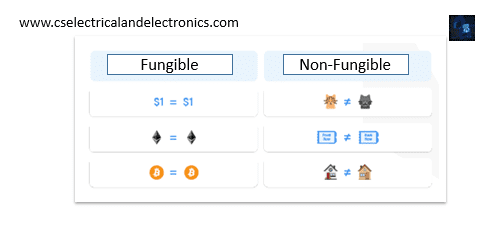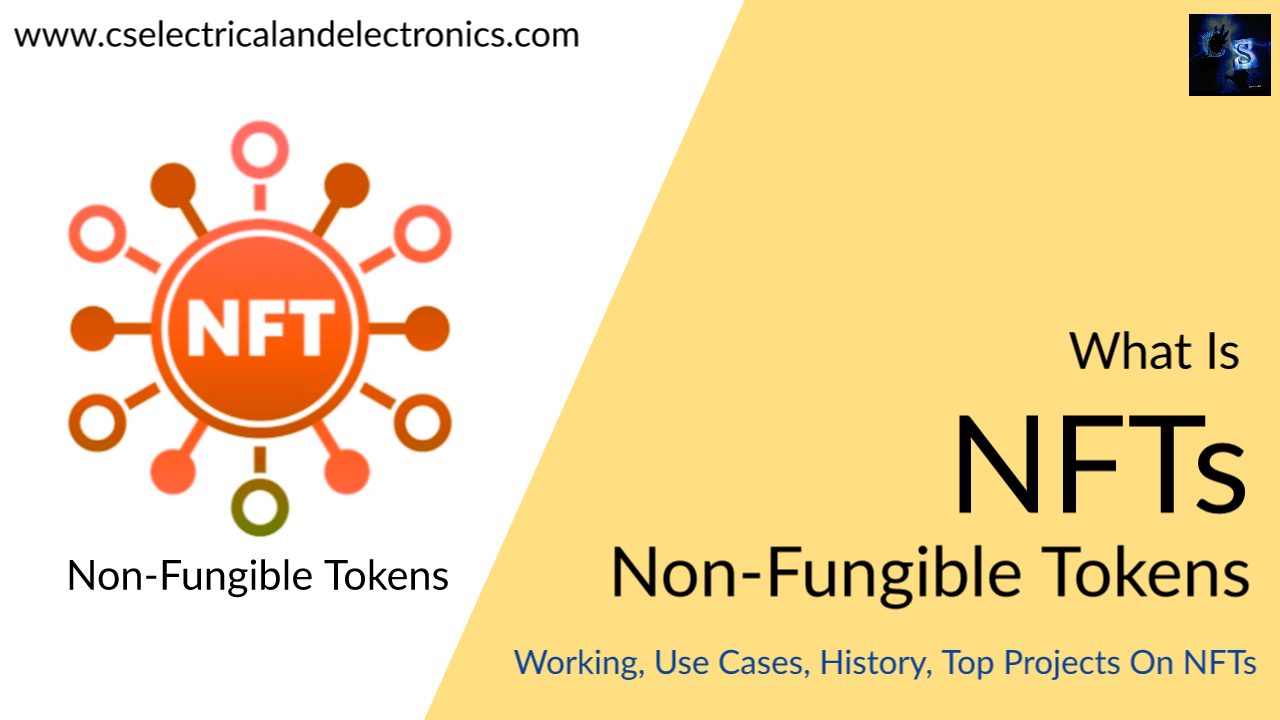What Is NFT, Non-Fungible Tokens, Working, Applications, History
Hello guys, welcome back to my blog. In this article, I will discuss what is NFT, non-fungible tokens, the working of NFT, its applications or uses, how it came into existence, why it is called non-fungible, NFT projects, etc.
If you have any doubts related to electrical, electronics, and computer science, then ask questions. You can also catch me @ Instagram – Chetan Shidling.
Also, read:
- Top 10 Artificial Intelligence AI Tools For Stock Market Traders, Investors
- Applications Of Data Structures And Algorithms In The Real World
- How To Install CYGWIN On Windows 10 Step By Step Procedure
What Is NFT, Non-Fungible Tokens
While the crypto society has been fascinated with Defi, non-fungible tokens (NFTs) have been increasing in popularity, gradually but surely. NFTs permit digital scarcity and provable license of unique, it is a kind asset. In this article, we will familiarize you with non-fungible tokens and the diverse platforms where you can utilize and trade them.
What is Fungibility?
Before we delve into the complexities of NFTs, it’s worth examining the difference between “non-fungible” and “fungible.” A fungible entity or token is, for all plans and purposes, interchangeable with another division of the identical thing.
For example, one Bitcoin is similar to another Bitcoin, simply like 1 US dollar is equal to another US dollar. If you loan your buddy/friend a $10 note, you wouldn’t require them to repay the loan with the exact $10 note – any $10 note will be fine.
Items that are non-fungible, on the other side, are not interchangeable with one another and will have unique properties that can create them radically dissimilar from one another, even though they may look identical.
There are numerous examples of non-fungible objects in the real world, such as images, videos, paintings, music, concert tickets, and so on. Although two paintings may look identical, they may hold drastically different grades of rarity. Likewise, front row tickets at a show are considerably more valuable than tickets for the backside row.

What are Non-Fungible Tokens?
This gets us to non-fungible tokens (NFTs). What are they, and how are they distinct from non-fungible digital assets like online products, domain names or Twitter handles? Non-fungible tokens are an incredibly powerful type of token that qualifies for a flexible way to express non-fungible assets on a blockchain. Their primary properties are:
01. Unique: Non-fungible tokens have within their code information that represents the properties of per token that create them different from others. A sample of digital art might have coded data about individual pixels, while tokenized in-game items might hold details that permit the game client to understand which object the player owns and its attributes.
02. Periodic: In order for non-fungible tokens to be attractive for buyers, they should be provably insufficient. This will guarantee that assets stay desirable in the long run, and that supply does not outstrip need.
03. Traceable: Each NFT has a record of trades on-chain, from when it was made, including every moment it switched hands. This represents each token can be verifiably accurate, and not fake– apparently a very significant thing for owners and future buyers!
04. Inseparable: NFTs especially cannot be transacted as traces of a whole. Just like how one cannot buy half of a show ticket or trading card, non-fungible tokens cannot diverge into smaller sects.
05. Programmability: Like all standard digital assets and tokens created on smart contract blockchains, NFTs are completely programmable. CryptoKitties and Axie Infinity hold breeding mechanics coded straight into their tokens. Even better, functionality is feasible.
In other terms, NFTs combine the best features of decentralized blockchain technology along with non-fungible assets. Unlike regular digital assets that are allocated and regulated by centralized entities, which can be brought from you at any time, it is likely to truly own and control your own NFTs.
Application Or Use Cases Of NFTs
As you can guess, NFTs can be quite powerful since they can symbolize literally any asset, digital or real. Below we added just some uses for NFTs or applications of NFTs:
01. Craft: With the launch of the craft marketplace Rarible and their yield agriculture incentive program, tradeable digital art has evolved into a hot topic. NFTs permit artists to monetize their paintings and safeguard their copyright. NFTs also permit artists to obtain royalties every time their products change hands.
02. Real-World Assets: One of the initially conceived objectives for NFTs was to tokenize real-world assets that can then be sold. OpenLaw developed a method to trade real estate utilizing the ERC-721 token standard, and Nike previous year also patented a system to tokenize shoes.
03. Notable Collectibles: With the preferences of CryptoPunks and CryptoKitties, we have noticed that NFTs can be utilized to create extremely sensual new kinds of digital collectibles. More classic collectors’ items such as old metal coins, baseball cards, and stamps are also being tokenized.
04. Gaming: Tradeable in-game objects are also one possible use case for NFTs. So distant, we have visited most performances revolve around turn-based battles or trading cards games such as Axie Infinity or Gods Unchained. With NFTs, yet, games such as Fortnite or CS: GO with dynamic item economizing may one-day license on-chain item trading!.
05. Virtual Assets: The Unbeatable Domains and Ethereum Name Service have diverted .crypto domain and .eth titles into NFTs, which can then be sold. Real estate in virtual worlds Cryptovoxels and Decentraland have also existed tokenized into NFTs.
History of NFT Or Non-Fungible Tokens
non-fungible tokens retain been about for longer than you might believe. Behind Bitcoin’s founding in 2009 and the initial outbreak in token types such as Ripple, Litecoin, and so on, multiple people were examining to innovate on blockchain technology to make newer, better powerful tokens. In this area, we will step you via a brief history of Non-Fungible Tokens NFTs.
Colored Coins
The most earlier prototypes of non-fungible tokens existed arguably colored coins, which stood first developed in a blog post by Yoni Assia in March 2012. These were extremely small units of Bitcoin which existed “colored” with distinct attributes coded into metadata utilizing Bitcoin’s scripting language. In this course, units as little as one satoshi (0.00000001 BTC) could convey any asset you can presume, be it a dollar, stakes in a company, a home, or digital collectibles. Although the idea of colored coins was very good and potentially effective, they had significant flaws and roadblocks:
- The Bitcoin network didn’t support colored coins. Therefore, it was up to wallet providers to identify the presence of colored coins.
- The lowest transaction size for a Bitcoin transaction before then was patched to be 5,430 satoshis (0.000543 BTC), which was considerably too large for the execution of colored coins.
Counterparty.io
Counterparty was established in 2014, making on the concept of colored coins to give non-fungible and semi-fungible tokens. Counterparty’s inventors understood that Bitcoin did not sustain the features that would qualify for the creation of robust support innovation and trading platforms.
Top Projects in NFTs
01. Aavegotchi: Own and trade avatars funded by interest-bearing tokens symbolizing loans on Defi lending platform Aave.
02. Cryptovoxels: Purchase land in this virtual globe, create stores and art galleries, and broadcast events.
03. Sorare: Fiction football game where users can manage, trade, and field partaker cards.
04. Ethereum Name Service: Register a named .eth domain to accept payments.
05. Decentraland: Virtual planet established in Ethereum, where users can sell virtual real estate.
06. Axie Infinity: Manage, expand, and multiply Axie to carry into battle.
07. Meme: Farming tokens that can be utilized to save limited edition collectible NFTs.
08. SuperRare: Marketplace only for the digital craft.
This was about ” What Is NFT, Non-Fungible Tokens “. I hope this article may help you all a lot. Thank you for reading.
Also, read:
- 100+ C Programming Projects With Source Code, Coding Projects Ideas
- 1000+ Automotive Interview Questions With Answers
- 1000+ Interview Questions On Java, Java Interview Questions, Freshers
- App Developers, Skills, Job Profiles, Scope, Companies, Salary
- Applications Of Artificial Intelligence (AI) In Renewable Energy
- Applications Of Artificial Intelligence, AI Applications, What Is AI
- Applications Of Data Structures And Algorithms In The Real World
- Array Operations In Data Structure And Algorithms Using C Programming

